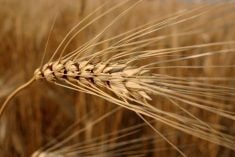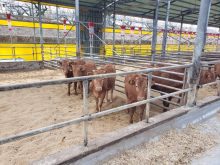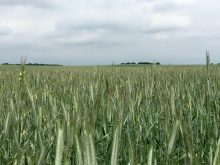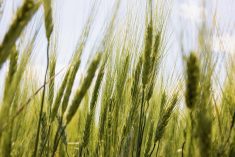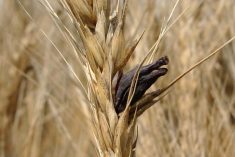Ergot is a fungus that can grow on certain grasses and grain plants when moisture conditions are just right. Ergot becomes a problem mainly after a wet season, rarely during dry conditions. The fungus replaces seed in the seed head with a dark-brown/black mass and produces toxic alkaloids. One or more of the kernels in the seed head are replaced with this dark, hard “ergot body.”
There are various types of alkaloids in ergot that affect cattle in different ways. One response is due to effects on the nervous system, resulting in muscle spasms in the hind legs, inco-ordination, loss of balance, and sometimes a temporary paralysis.
Read Also

Harvest wraps up and fall work begins
At the Eppich famly ranch in western Saskatchewan, the fall harvest was successful with few breakdowns, cows and calves have been sorted and a new tractor has arrived
Perhaps more commonly the toxic alkaloids impair blood circulation to the extremities (due to constricting of blood vessels), which can result in loss of ears, tail or feet.
Mild cases of ergot poisoning may simply show up as poor animal performance (lower weight gain, drop in milk production, inability to handle hot or cold weather, reproductive problems, or abortion). The alkaloids tend to restrict blood flow and milk flow.
Grains are susceptible
Ergot is most common in grains, but can also infect wheatgrass, brome, wild rye and a number of other wild grasses. An ergot fungus that grows mainly on rye produces a condition called ‘ryegrass staggers’ in cattle. Another type of ergot infects barley and creates another class of toxins. Often the signs of ergot poisoning are similar to those of fescue toxicosis, with a rise in body temperature, reduced milk production, reduced growth rate, and poor circulation to the extremities.
Barry Yaremcio, beef and forage specialist with Alberta Agriculture and Forestry, says the ergot and alkaloids produced by the fungi vary considerably around the world. There are also some major differences found, even in North America.

“A lot of research is being done right now in Saskatchewan on ergot,” says Yaremcio. “They are looking at how it develops, and how long it takes for that ergot body to start putting the alkaloids into the seed. Feeding trials are being done at the University of Saskatchewan to determine the threshold before producers see reduced performance in the animals caused by alkaloids in ergot contaminated feeds.”
Research over the past couple years at the Western College of Veterinary Medicine has identified certain strains in Western Canada that are two to four times more virulent and harmful than strains seen in Texas, Oklahoma and Florida, for example.
Rules have changed
“The old rules of thumb for safety levels (one kernel in 1,000, or about 10 ergot bodies per litre of grain) are completely invalid in these cases,” says Yaremcio. Due to the high toxicity, tolerances for ergot are very tight, and should be more like one ergot body per 10,000 kernels. The Animal Nutrition Association of Canada has hired Brian Doig, who recently retired from Saskatchewan Agriculture, to co-ordinate all the information.
“Researchers and nutritionists are trying to get the Canadian Food Inspection Agency to readjust the recommendations and actually put forth some limits and regulations, rather than just guidelines for feed,” says Yaremcio. “Many people know if they have ergot in the feed they will have problems in cattle with tails and hooves sloughing off, but unfortunately that’s one of the last symptoms to show up, just before these animals die.”

Cattle don’t find ergot infected feeds very palatable. “One of the first symptoms, particularly in heavily infected feed is seeing cattle will back off feed within two or three days,” he says. “They may reduce their intake of that feed by 60 to 70 per cent. This is your warning sign.”
Yaremcio says if the infected feed isn’t removed or replaced, the health of cattle will be adversely affected.
“You’ll see problems with many of the diseases that we normally associate with stress, such as at weaning and shipping,” he says. “That includes IBR, shipping fever, pneumonia, and other respiratory problems. These tend to show up in cattle that have been affected by ergot.” He also says some ranchers in Western Canada have lost cows, due to ergot contamination in pellets.




